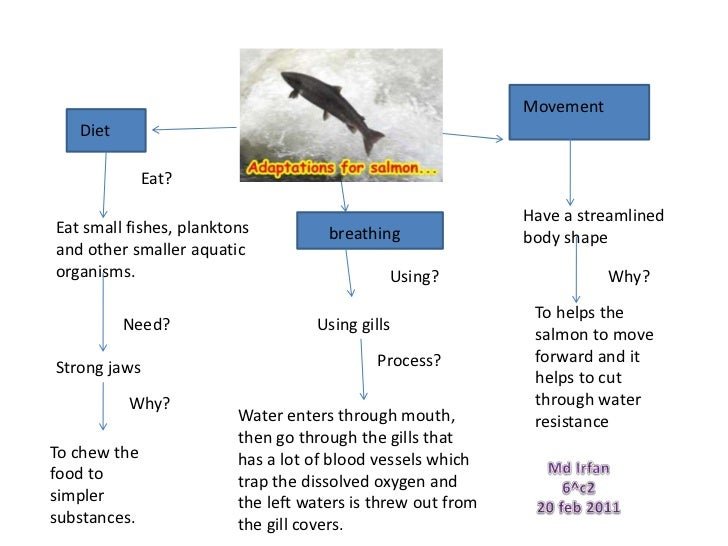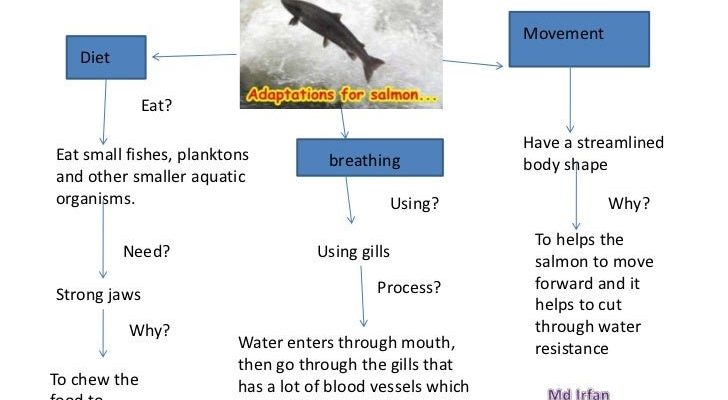
When we look at salmon, we see more than just fish swimming in rivers; we see a story of evolution and survival. These creatures face various challenges, from shifting water currents to predators lurking in shadows. So what exactly allows them to navigate their watery habitats so expertly? Let’s dive into the incredible adaptations that help salmon not just survive but thrive underwater.
1. Streamlined Bodies for Efficient Swimming
One of the first things you’ll notice about salmon is their sleek, streamlined bodies. This shape isn’t just for looks—it’s incredibly functional. Imagine trying to swim through water with a bulky body; it would be like trying to run a marathon in a heavy winter coat. Salmon are built for speed and agility, which is crucial for escaping predators and migrating upstream.
The fish’s torpedo-like form reduces drag as they move through water. This streamlining allows them to swim more efficiently, using less energy while traveling long distances. When a predator strikes, that speed can be the difference between life and death. Think about a sleek sports car zipping past a stuck van in traffic; that’s similar to how a salmon uses its design to navigate its environment.
2. Powerful Fins and Tails
Salmon are equipped with strong fins and tails that play a critical role in their movement. The tail, or caudal fin, acts like a motor, propelling them through the water with powerful strokes. They can control their speed and direction with astonishing precision, almost like dancers moving gracefully across a stage.
The pectoral and pelvic fins also help with balance and maneuverability. When salmon swim upstream, often against strong currents, these fins help them stabilize and steer. Imagine trying to climb a staircase while someone pushes you from behind; you’d need to brace yourself, just like salmon do with their fins. This combination of strength and flexibility allows salmon to excel in various aquatic environments.
3. Gills for Efficient Oxygen Extraction
If you’ve ever been out of breath after a short sprint, you know how vital oxygen is. For salmon, gills are their lifeline. These specialized organs extract oxygen from the water, allowing them to breathe underwater. Here’s the thing: as salmon swim, water flows over their gills, and tiny blood vessels within the gills pick up oxygen while releasing carbon dioxide.
This efficient system is crucial, especially in high-energy activities like swimming upstream. Some salmon even have the ability to adapt their gill structures based on their environment, optimizing their oxygen intake. It’s like having a high-performance sports car that can adjust its engine based on the terrain—it helps them keep going, even in challenging conditions.
4. Camouflage and Coloration
Salmon come in various colors and patterns—think of bright reds, silvers, and even speckled shades. This coloration isn’t just for show; it serves a significant purpose. Underwater, certain colors can help salmon blend into their surroundings, making it harder for predators to spot them. This ability to camouflage provides a valuable edge, especially in shallow waters or among rocks and plants.
Conversely, during spawning season, salmon develop brighter colors to attract mates. You might wonder why they would flaunt their beauty when predators are around. The answer lies in the balance of risks; being vibrant can help ensure reproductive success, which is essential for the species’ survival. Just like peacocks show off their feathers to attract a mate, salmon have their own way of making a statement in the water.
5. Sense of Smell for Navigation
Imagine wandering through a dense forest without a map, relying solely on your nose to find your way. For salmon, this is a bit like their real-life experience in the water. They have an outstanding sense of smell, which helps them detect everything from food to potential dangers and even mates. It’s believed that salmon can recognize the unique chemical signatures of the waters in which they were born, guiding them back to their spawning grounds.
This incredible olfactory ability allows salmon to thrive in their environment. When searching for food, they can sniff out tasty treats like insects and small fish from a distance. It’s almost like having a superpower that helps them not only survive but also navigate through sometimes murky waters.
6. Resilience to Freshwater and Saltwater
Salmon are true champions when it comes to adapting to different water conditions. They are anadromous, meaning they spend part of their lives in freshwater rivers and streams and part in saltwater oceans. This transition isn’t as simple as packing a bag for a vacation; it requires significant physiological changes.
When salmon migrate from saltwater to freshwater, their bodies have to adjust to the different salt concentrations. They basically switch from being “ocean fish” to “river fish,” and this ability makes them incredibly resilient. It’s like a person learning to navigate a new city after moving—though it takes time and adjustment, the versatility opens up new opportunities. This adaptability is key to their life cycle and ensures their successful reproduction.
7. Social Structure and Group Dynamics
Salmon are social creatures, often swimming in schools. This behavior isn’t just for companionship; it’s a survival strategy. Groups can confuse predators, making it harder for them to target a single fish. Picture a flock of birds taking off in different directions when they sense danger—that’s how schools of salmon operate.
In addition to protection, swimming in schools allows salmon to share resources and navigate more effectively. They can communicate through body language and vibrations in the water, enhancing their ability to respond to threats. This cooperative behavior helps ensure their survival, allowing them to thrive even in unpredictable environments.
8. Energy Storage and Migration
Lastly, salmon have a remarkable ability to store energy in the form of fat. This adaptability is vital during long migrations. When they prepare to spawn, they build up reserves that sustain them during their journey upstream—a grueling trek that can span hundreds, even thousands, of miles.
This energy storage strategy is similar to how some animals hibernate. They know that when the going gets tough, they have fuel to keep moving forward. As salmon make their way upstream to lay eggs, their bodies rely on these stored fats to push through, demonstrating their resilience and determination.
In conclusion, salmon are more than just beautiful fish gliding through our waters; they are champions of adaptation. With traits that allow them to swim efficiently, breathe easily, and navigate their environments with precision, they’ve mastered the art of survival. These adaptations not only help them face challenges but also ensure their legacy continues in the changing world of water. So, the next time you spot a salmon swimming upstream, remember there’s a lot more going on beneath the surface.

